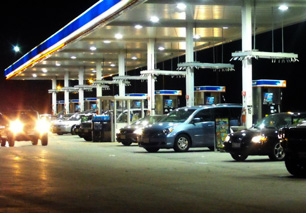1,2-Dichloropropane (DCP)
| EPA Maximum Contaminant Level (MCL) |
0.005 mg/L |

DCP is used in the manufacture of unleaded gasoline.
1,2-Dichloropropane (1,2-DCP) is an organic chemical used in the manufacture of unleaded gasoline, paper coating, paint remover, metal degreasing agents, dry cleaning fluid, and as a solvent for fats, oils, resins, waxes and rubber. It's also used in agriculture as a pesticide for nematodes and peach tree borers.
DCP arrives in water mainly through discharge from factories.
Health Effects of Dichloropropane
The World Health Organization reports that in the several cases of dichloropropane poisoning that have occurred, mainly the central nervous system, liver and kidneys were affected. Although the International Agency for Research on Cancer (IARC) does not classify it as a carcinogen (studies remain limited), the EPA warns of an increased cancer risk:
Some people who drink water containing 1,2-dichloropropane in excess of the maximum contaminant level [0.005 milligrams per Liter] over many years may have an increased risk of getting cancer.
Water Treatment for Dichloropropane
The EPA recommends granular activated carbon (GAC) combined with packed tower aeration (an air stripping method) for the treatment of dichloropropane. Lenntech reports that activated carbon has a “high probability” of removing dichloropropane on its own.
Sources: EPA, WHO, Lenntech, Photo: WikiMedia, author: Verne Equinox
Site Index
Filtration Systems
- Aeration for Iron & Sulfide
- Backwashing Filters
(whole house & well units)
- Chlorine & Chemical Injectors
- Countertop Water Filters
- Emergency Filters
- Garden Hose Filters
- Reverse Osmosis, Residential
- Reverse Osmosis, Commercial
- Shower Filters
- Specialty Filters
- Ultraviolet Systems
- Undersink Filters
- Water Softeners
- Whole House Filters
Cartridges
Parts
- Replacement Parts
- Faucets
- Filter Media
- Fittings
- Housings
- O-rings
- Pumps
- Pura UV
- R.O. Parts
- R.O. Tanks
- R.O. Booster Pump
- VIQUA UV